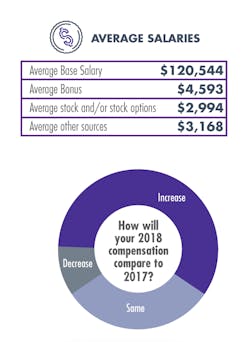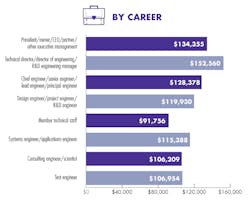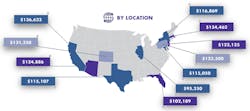In this third installment of our annual Microwaves & RF Salary & Career Report, we examine a topic that’s of interest to many engineers—salary. What do salaries in the industry currently look like? Or maybe a better question is: Are engineers being sufficiently paid? Let’s look at how the survey numbers stacked up.
This year, respondents reported an average base salary of $120,544.37, which is a slight increase over last year’s number of $112,840. In 2016, average base salary was $110,844, and the year before that, it averaged out to $109,533. What’s evident is that base salaries saw slight increases each year over the last three years—certainly a positive trend in the industry.
On top of that, this year’s respondents reported an average bonus of $4,593.45. That’s also a slight increase over last year’s number of $4,294.
When asked how their total 2018 compensation (salary, bonuses, etc.) compares to what they earned in 2017, about 59% of respondents said their compensation has increased. About 71% of those who reported an increase had their compensation grow by 5% or less—that’s not a big surprise. What could be considered an eye-opener is that slightly under 19% of respondents who reported an increase were compensated at least 10% higher than the prior year. If you happen to be one of them, then congratulations to you!
On the other side of the fence, 31% of respondents said their compensation remained the same. And, unfortunately, just under 10% said their compensation actually decreased.
One statistic that might catch your attention is the average salary among respondents with one to four years of experience—it came in at around $82,000. Not too shabby a number for those engineers who are still so early in their careers. Respondents with 35 to 39 years of experience reported the highest base salary of approximately $142,000.
In terms of location, those who work in California and Massachusetts reported the highest salaries. The RF/microwave industry is loaded with companies in those two states—and it appears that those companies are compensating engineers well, too. The average compensation among respondents who work in Colorado, Arizona, Pennsylvania, and New Jersey was also slightly higher than the overall average.
Respondents were also asked, “Generally speaking, in what ways have compensation policies and procedures changed for engineers at your organization during the past year? Are you being asked to shoulder more of the responsibility for the costs of benefits (i.e., health insurance)? How have incentive programs changed? Are these new methods of compensation temporary, or permanent?”
This elicited some interesting replies. One respondent said, “Health insurance goes up slightly each year. Otherwise, there isn't much change year over year. Raises could be better, but I think that is pretty much status quo in the industry. Companies pay more to lure in talent than to keep talent.”
Another respondent quipped, “Increases in health insurance premiums negate most of my yearly increases in compensation.” And yet another said, “Health care increases seem to happen every year. Last year was the highest increase.” While we won’t get into the cost of health insurance here, these comments reveal that increases in compensation don’t necessarily mean that engineers are taking home a higher paycheck.
Keep an eye out for the next installment, which will cover new technology.






